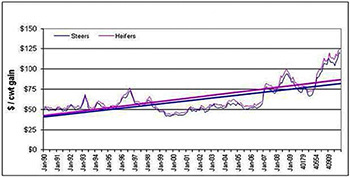Did You Know … ?
We can hit today’s consumer targets without having to absorb higher COG levels.

Larry Corah
When does the cost of gain (COG) exceed the fed-cattle price? Historically, it almost never does unless weather-related feeding conditions ramp up those costs. Until now.
Shawn Walter, head of Oklahoma-based Professional Cattle Consultants (PCC), delved into the dynamics in a recent newsletter and noted COG on a live-cattle basis has persisted in the $135-per-hundredweight (cwt.) area since March, with fed prices hovering around $125. That’s a staggering spread for cattle feeders to absorb — nearly impossible without better cattle that beat the spread and add premiums. Such pressure helped build a new mind-set that looks at grid marketing and carcass gain vs. cash sales and live gain in those last weeks on feed.
Still, it’s striking to look at how liveweight COG has changed in the past five years. Justin Waggoner, Kansas State University feedlot specialist, shared data (see Fig. 1) that showed for the first 17 of 22 years, COG averaged around $50-$55 per cwt. Then, in 2007, the “ethanol era” had its impact.
How does COG relate to the kind of Certified Angus Beef® (CAB®) acceptance rates we’ve seen? Looking at our feedlot database, two things become apparent. As closeout average daily gains improved, CAB® acceptance improved, but corresponding feed efficiency was a bit off. The net effect in COG for higher-grading cattle was slightly lower in a PCC white paper (Table 1), but practically about even.
| Table 1: Profit Profile — Quality Grade (QG) effect | ||||||||
Low QG |
Middle QG |
High QG |
||||||
| % Choice or higher | 35.3 | 54.1 | 74.5 | |||||
| % CAB® | 5.4 | 11.1 | 20.1 | |||||
| Cost of feedlot gain, $ | 63.92 | 62.86 | 62.10 | |||||
| Profit/loss, $ | 26.69 | 33.68 | 44.18 | |||||
| Source: PCC white paper, "Profit Profiles: Factors Driving Cattle Feeding Profitability." | ||||||||
That casts doubt on an old adage in cattle feeding that says to get high levels of Prime or premium-Choice cattle, they have to be fat enough to give up COG. That idea does not fit the kind of cattle we have now. We can successfully hit today’s consumer targets without having to absorb higher COG levels.

Editor’s Note: Larry Corah is vice president of Certified Angus Beef LLC.






